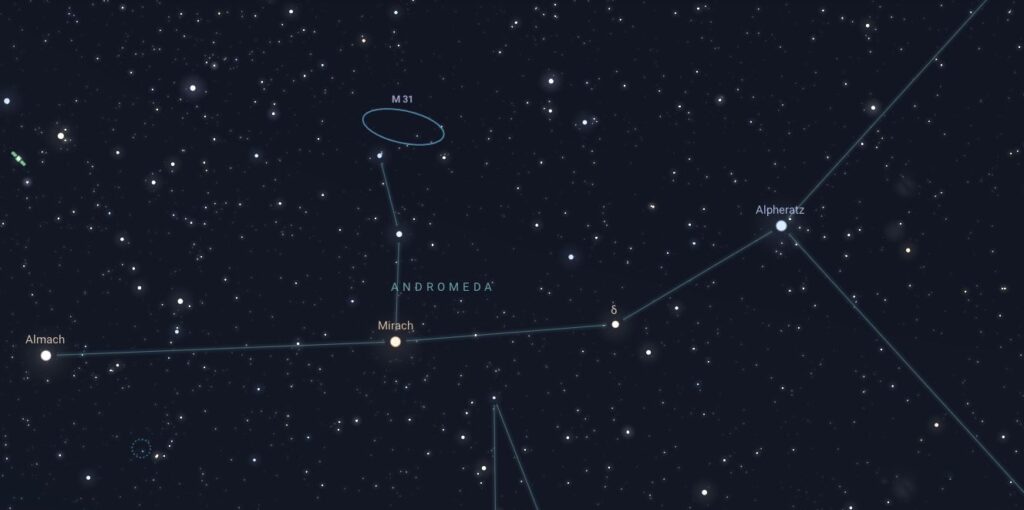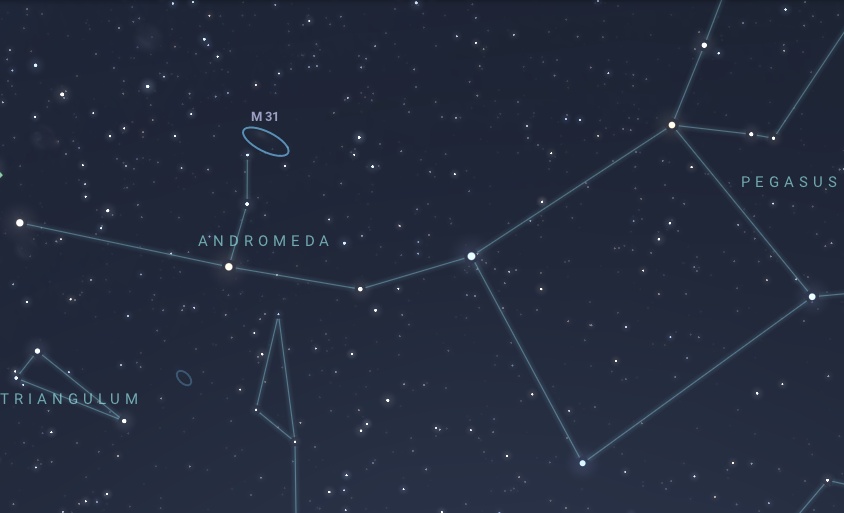Andromeda is one of 88 modern constellations and is named after the princess Andromeda from Greek mythology. It is located in the northern hemisphere and is bordered by several other prominent constellations, including Perseus, Cassiopeia, Pegasus, and Pisces. The constellation is most famously associated with the Andromeda Galaxy (M31), the nearest spiral galaxy to the Milky Way.
Key Stars within Andromeda
The Andromeda constellation features several notable stars, including:
Alpheratz (Alpha Andromedae): Often considered the brightest star in Andromeda, Alpheratz is part of the neighbouring constellation Pegasus. This binary star system is located approximately 97 light-years away from Earth and has a visual magnitude of 2.07. It marks the top of the “W” shape formed by Andromeda and is one of the prominent stars in the region.
Mirach (Beta Andromedae): A red giant star located about 200 light-years away, Mirach is part of the asterism known as the “Great Square of Pegasus,” despite being officially classified in Andromeda. It has a visual magnitude of 2.05, making it one of the brighter stars in the constellation. Mirach serves as a useful guide to locating the Andromeda Galaxy.
Almach (Gamma Andromedae): Also known as Almach or Alamak, this multiple star system consists of at least four stars. Located approximately 350 light-years away from Earth, Almaak has a visual magnitude of 2.23. Its distinct blue and yellow components make it a favourite target for amateur astronomers, offering a beautiful contrast when viewed through telescopes.
Delta Andromedae: This star, with a magnitude of 3.27, is a yellow giant located about 102 light-years away from Earth. It lies within the northeastern part of the constellation.
Mu Andromedae: With a magnitude of 3.87, this star is located about 180 light-years away and is situated near the heart of the constellation. Although it is fainter than some of Andromeda’s other stars, it is still a notable feature in the constellation.

Andromeda Galaxy (M31)
One of the most famous features of the Andromeda constellation is the Andromeda Galaxy (M31). It is the largest galaxy in the Local Group, which includes the Milky Way, the Triangulum Galaxy, and about 54 other smaller galaxies. Located around 2.54 million light-years from Earth, M31 is the closest spiral galaxy to the Milky Way and can be seen with the naked eye as a faint, elongated patch of light. Through binoculars or telescopes, it reveals its spiral structure, with a bright central bulge and sweeping spiral arms.
Additionally, the constellation contains NGC 891, a notable edge-on spiral galaxy located around 30 million light-years away. NGC 891 is valuable to astronomers for providing insights into the structure and composition of spiral galaxies due to its nearly edge-on appearance.
Visibility
The Andromeda constellation is best observed during the autumn and winter months in the Northern Hemisphere, typically from September to January. During this time, Andromeda rises in the northeastern sky during the early evening and remains visible throughout the night, reaching its highest point in the sky around midnight. It is an excellent target for both amateur and professional astronomers due to its rich collection of stars and galaxies.
In the Southern Hemisphere, Andromeda is not easily visible because it lies so far north in the sky. However, observers in the southernmost regions may catch glimpses of it low on the northern horizon during late autumn and early winter.



